When John Minton committed suicide in 1957, the unfinished painting left on his easel was poignantly symbolic. Redolent of a pietà, Composition: The Death of James Dean, currently on show in an exhibition of Minton’s works at Pallant House, was the last in a series of history paintings that occupied the artist during his final years. In its acknowledgement of academic tradition it was a stonking anachronism, its very existence suggestive of the inner turmoil of a man who had been precociously successful, only to find himself irrelevant and outmoded aged just 39.
The painting’s grand scale was a calculated riposte to the machismo of Abstract Expressionism, and in this series of history paintings Minton attempts to marshal the full force of the western figurative tradition. To onlookers though, it was an act of desperation; a student commented: ‘You could see the panic, he was striking out in all directions trying to be a painter.’
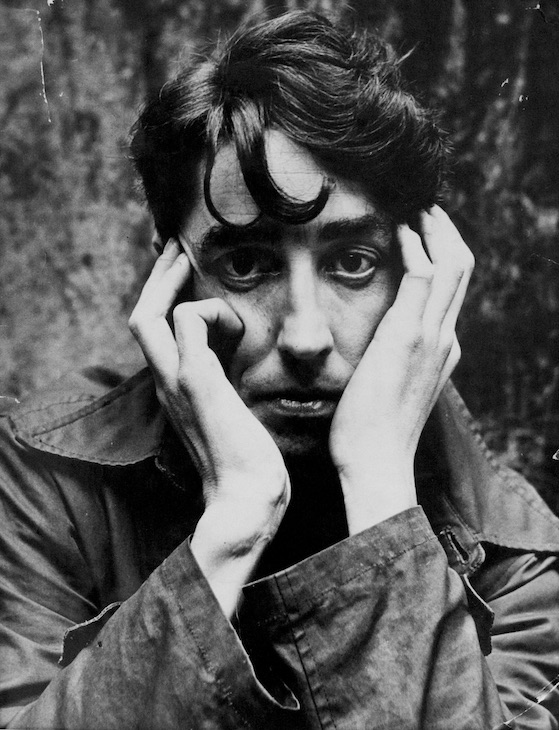
Portrait of John Minton by John Deakin, Soho, 1951. Image courtesy of Michael Hoppen Gallery; © The Condé Nast Publications Ltd
The canvas hints at the presumed causes of Minton’s suicide, which extended beyond his frustrations with the state of post-war painting, to his struggles with homosexuality. His work frequently contains figures who are, if not frank self-portraits, then projections of some aspect of himself, and in the person of James Dean, a gay icon and poster boy for outsiders and misfits, Minton seems to have identified a kindred spirit.
In desolate imaginary landscapes painted in Paris just before the Second World War, emaciated youths seem likely proxies for Minton. Influenced by de Chirico and the French Neo-Romanticism of Russian emigrés Eugène Berman and Pavel Tchelitchew, Minton was adept at producing emotionally affecting, if overwrought, compositions.
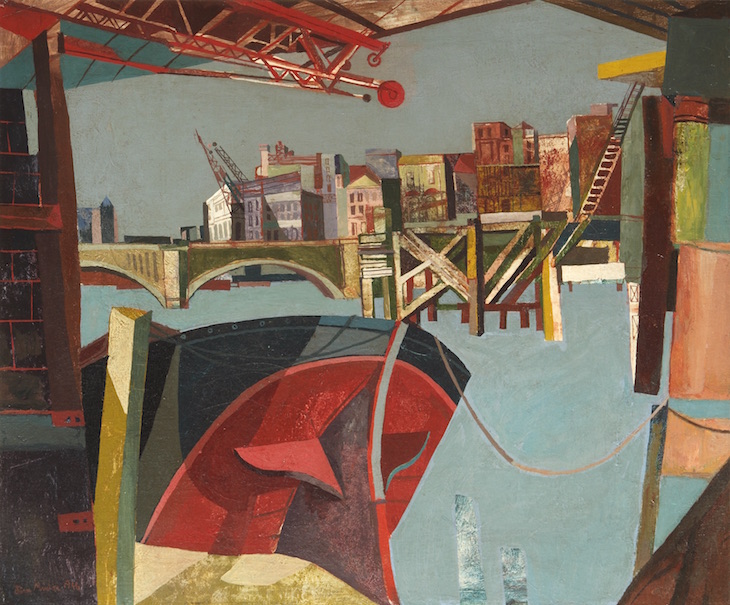
Bridge from Cannon Street Station (1946), John Minton. Pembroke College Oxford JCR Art Collection. © Royal College of Art
His fascination with ruins found a more refined expression in response to London’s bomb-ravaged cityscape. It is perhaps Minton himself who loiters in the shadowy foreground of Figure in Ruins (1941), while in Bomb-Damaged Buildings, Poplar (1941), the ruined cityscape itself constitutes a troubling psychological portrait.
An otherwise disastrous stint in the army brought with it fresh inspiration from the British landscape, which Minton imbued with the mystical, dreamlike qualities that he admired in the work of Samuel Palmer. With their restless movement and crowded compositions Minton’s series of large-scale landscape drawings subvert Palmer’s pastoral idyll; even Surrey Landscape (1944), an ostensibly tranquil scene, resolves into tension. The framing of the landscape, and Minton’s ability to direct our gaze through the piece, is indicative of not only his talent for illustration, but also stage design – two activities that ran alongside his work as a fine artist.
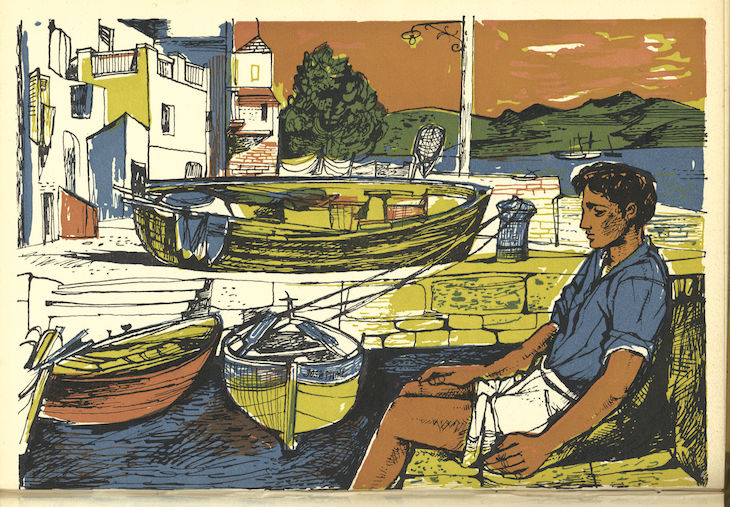
Illustration from Time Was Away. A Notebook in Corsica by Alan Ross (c. 1948), John Minton. Royal College of Art, London
As for so many artists, a number of whom feature in the companion exhibition ‘A Different Light: British Neo-Romanticism’, the end of the war made travel a possibility once again. Minton’s illustrations for Elizabeth David’s cookery books, and for the Corsican travel notebook Time was Away, which he worked on with the poet Alan Ross, reflect the mood of a nation keen to abandon wartime austerity.
Travel proved fertile ground, the themes of his illustration work recurring in his paintings, notably a whole series of canvases relating to fish and Corsican fishermen. Strikingly modernist, Fish in a Glass Tank (1949), highlights too the immense impact of the V&A’s Picasso and Matisse exhibition from 1945–46, its bright colours, flattened space and decorative zeal clearly indebted to their influence.
Modernist tactics elevate less glamorous subject matter, and in his scenes of working life, which reflect the socialist tendencies of post-war Britain, Minton found his own voice as an ‘urban romantic’. Industrial paraphernalia takes on a certain dignified beauty, the graphic quality of his bold designs recognised by London Transport, who issued London’s River (1951) as a poster.
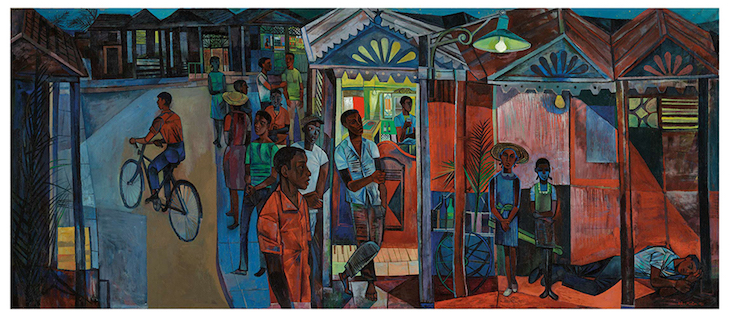
Jamaican Village (1950), John Minton. Private collection. Photo: © 2016 Christie’s Images Limited/ Bridgeman Images; © Royal College of Art
A sophisticated sense of design, coupled with an ability to convey tension characterises Minton’s work, notably in the recently discovered Jamaican Village (1951). The way that he directs and evokes light is pivotal here, the darkness of the night contrasting with the directional glare of a lightbulb, making a fascinating comparison with the flat, unmodulated colours and simple geometric design of The Road to Valencia (1949), which exudes the unrelenting heat of southern Spain.
Minton’s facility with design made him an unsettling portraitist, and viewed from a characteristically high viewpoint, his subjects – always young men and often his lovers – seem unwittingly vulnerable and yet simultaneously inaccessible. His portrait of carpenter Kevin Maybury is particularly poignant for it was he who found Minton’s body. Belying his relaxed pose, Maybury looks away, lost in his own thoughts, his carpentry tools and the wooden structure of Minton’s empty easel creating an elaborate barrier around him. Here, as in passages of the history painting The Dice Throwers (1954), the figurative seems close to collapse, the geometry of the piece threatening to give way to the abstract tendencies Minton had so fiercely resisted.
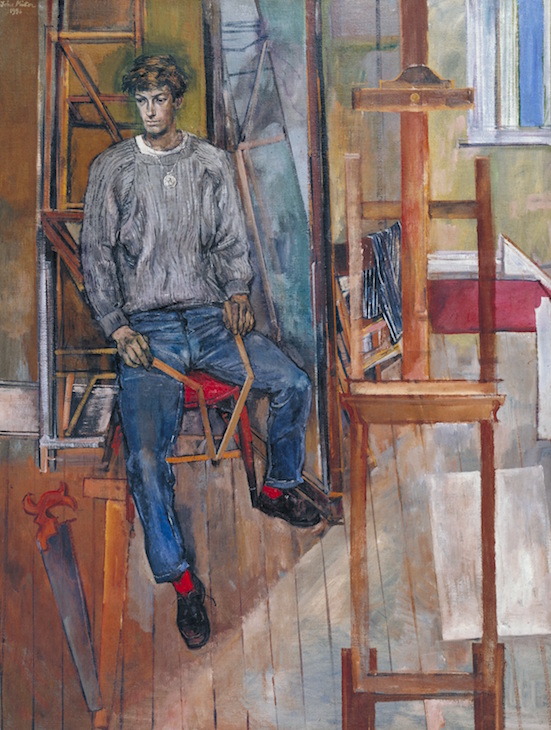
Portrait of Kevin Maybury (1956), John Minton. Tate. © The estate of John Minton
‘John Minton: A Centenary’ is at Pallant House Gallery, Chichester, until 1 October 2017.














![Masterpiece [Re]discovery 2022. Photo: Ben Fisher Photography, courtesy of Masterpiece London](http://zephr.apollo-magazine.com/wp-content/uploads/2022/07/MPL2022_4263.jpg)
‘Like landscape, his objects seem to breathe’: Gordon Baldwin (1932–2025)